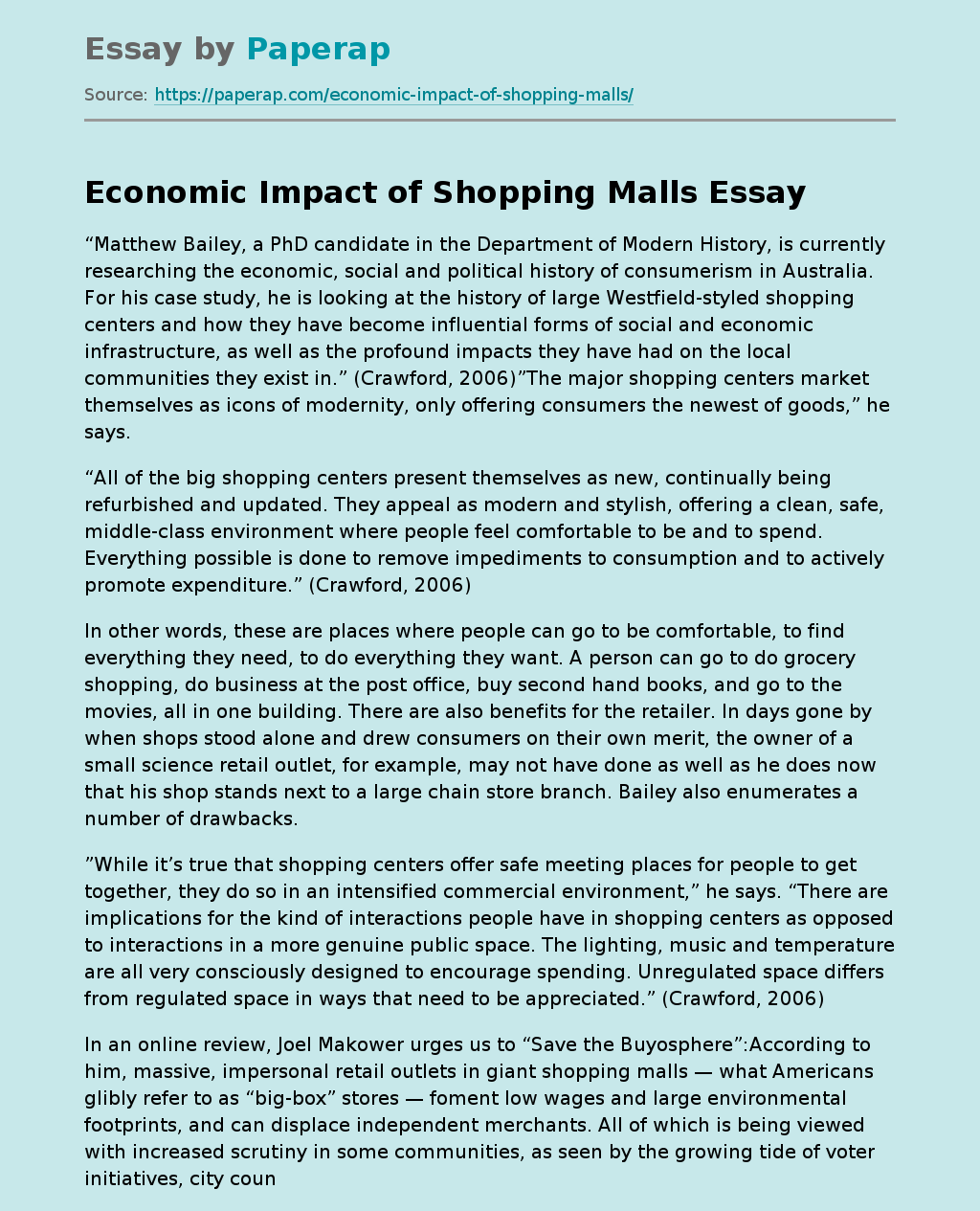Economic Impact of Shopping Malls
“Matthew Bailey, a PhD candidate in the Department of Modern History, is currently researching the economic, social and political history of consumerism in Australia. For his case study, he is looking at the history of large Westfield-styled shopping centers and how they have become influential forms of social and economic infrastructure, as well as the profound impacts they have had on the local communities they exist in.” (Crawford, 2006)”The major shopping centers market themselves as icons of modernity, only offering consumers the newest of goods,” he says.
“All of the big shopping centers present themselves as new, continually being refurbished and updated. They appeal as modern and stylish, offering a clean, safe, middle-class environment where people feel comfortable to be and to spend. Everything possible is done to remove impediments to consumption and to actively promote expenditure.” (Crawford, 2006)
In other words, these are places where people can go to be comfortable, to find everything they need, to do everything they want.
A person can go to do grocery shopping, do business at the post office, buy second hand books, and go to the movies, all in one building. There are also benefits for the retailer. In days gone by when shops stood alone and drew consumers on their own merit, the owner of a small science retail outlet, for example, may not have done as well as he does now that his shop stands next to a large chain store branch. Bailey also enumerates a number of drawbacks.
”While it’s true that shopping centers offer safe meeting places for people to get together, they do so in an intensified commercial environment,” he says.
“There are implications for the kind of interactions people have in shopping centers as opposed to interactions in a more genuine public space. The lighting, music and temperature are all very consciously designed to encourage spending. Unregulated space differs from regulated space in ways that need to be appreciated.” (Crawford, 2006)
In an online review, Joel Makower urges us to “Save the Buyosphere”:According to him, massive, impersonal retail outlets in giant shopping malls — what Americans glibly refer to as “big-box” stores — foment low wages and large environmental footprints, and can displace independent merchants. All of which is being viewed with increased scrutiny in some communities, as seen by the growing tide of voter initiatives, city council measures, and legal wranglings intended to slow, or stop, these stores’ steady march across the landscape. (Makower, 2006)
The same article continues in the following vein:While real problems may be lost amid such contretemps — concern over the environmental, economic, and social impacts of the “stuff” offered at these stores may take a back seat to the impacts of the stores themselves — Satterthwaite makes a convincing case that today’s retailers have a far, far different impact on communities than their predecessors of, say, a half-century ago. Back then, stores were community gathering spots, a source of daily contact, however small, with merchants, neighbors, and veritable strangers.
In many communities, stores were the only means people had of regular interaction with other humans. Today, mega-super centers, cloned strip malls, and e-commerce have largely removed the social component of shopping. (Makower, 2006)There are other drawbacks too – including the fact that in some countries shopping centers are prime areas to which criminals are attracted, knowing that large sums of money are stored on the premises and that young children are left alone there.We can see that there are both benefits and drawbacks to shopping malls.
Works Cited
- Crawford, Fiona “The rise and rise of the shopping mall” 4 Jan 2007 <http://www.pr.mq.edu.au/macnews/showitem.asp?ItemID=466
- Makower, Joel. “Save the Buyosphere – Consumer Behavior By the Book” 4 Jan 2007 ;http://www.worldchanging.com/archives//004577.html.;;
Economic Impact of Shopping Malls. (2019, Nov 27). Retrieved from https://paperap.com/economic-impact-of-shopping-malls/

